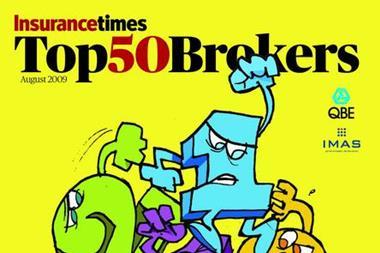It’s been a tough year on so many fronts, and although that has meant less dramatic changes in the Top 50 ranking than in previous years, the results make interesting reading. IMAS’s James Simpson takes a closer look at the finances and the fallouts – and hazards a guess at the coming year
The 2009 Top 50 Brokers includes several notable features:
• It continues last year’s growth in aggregate income.
• There has been significant consolidation.
• More participants than ever have “disappeared” from the rankings.
• There is evidence of the impact of the US dollar exchange rate on London and international brokers.
Although aggregate income has increased by 3.1% on 2008, it is not surprising given the weak pound. The US dollar exchange rate moved from $1.996 to $1.449 at 31 December 2008, a change of 27%, albeit that most brokers will have hedged this to a fair degree.
The biggest impact on the table has been the acquisition of Benfield (number 7 in 2008) by Aon (number 1 in 2008). We have used Aon UK’s 2008 figures and added Benfield UK’s 2007 figures to them, excluding the overseas elements of Benfield, to estimate the size of the UK business. Couple this with a strengthening US dollar and there has been a recovery at the top end for the international brokers. The consolidation effect is clear to see in the chart (below left), which is magnified (below right).
The rest of the mergers and acquisitions market was most active in early 2008, with the capital gains deadline of 5 April causing a rush. But the interesting transactions
took place later in 2008 and early 2009. The first was Highway Insurance being acquired by Liverpool Victoria in August 2008, which led to the sale of Hero Insurance Brokers to Capita in March 2009. In December, RK Carvill revealed it was closing and seeking to transfer its clients to brokers of their choice.
Then Insurance Australia Group announced it was selling Equity Insurance Brokers to Swinton and in February it announced that Hastings Insurance was being bought out by the management.
The one transaction that had the least impact in the UK but was very significant in the US was Willis’s acquisition of HRH. This resulted in Glencairn disappearing from the Top 50. In all, five companies exited.
THE RANKINGS
Although there have been mergers and acquisitions at the top of the table, the rankings have not changed that materially. But the impact of a weak sterling exchange rate has influenced international brokers’ revenues, pushing Saga/AA down two places.
Other changes have been less dramatic than in previous years because active consolidators have been fewer. It is only Giles that achieves any material change in its position – up five places this year to number 17.
However, a single material acquisition helped drive Capita up 11 places to 18, while general business development moved Group Direct up to 30 from 41.
NEWCOMERS
With the demise of five ranked participants from the 2008 listings there are five newcomers, only one of which was foreseen last year.
The highest ranked newcomer is Hastings Insurance, following its buy-out from IAG, which comes in at 24 (IAG/Equity was 12th last year). The next highest is Cobra at number 41 – a forecast entry from 2008 – followed by AHJ (Alwen Hough Johnson) at 46, Broker Direct at 49 and Oamps at 50.
GROWTH
Leaving out those that have benefited from the exchange rate changes, the growth patterns have changed again this year. There is more organic movement this year than the acquisition-driven previous years (see table, page 13).
The main consolidators have marked time, disclosing low single-figure growth; except for Giles, with 22% growth, and Jelf, with its 2007 acquisitions flowing though to achieve 44% growth. Acquisitions have also swelled the books at Swinton, fuelling 34% growth, and at Capita with 94%.
Organic growth has been seen with Group Direct at 42% and Kwik-Fit at 19%. Meanwhile, BGL’s growth of 15% represents the largest monetary increase at more than £34m of new income.
What is interesting is that the personal lines brokers have grown in a market where the price comparison websites have been having a material impact.
The largest percentage growth, 80%, has come from Oamps, helping it to enter the Top 50 for the first time. Some of this has been through small acquisitions, but a significant proportion has been from organic growth in its specialist areas.
Looking at sector growth, the playing field is much more level than in previous years. Consistent growth from the personal lines sector impresses, and the recovery of London and international brokers (see table, below).
PROFITABILITY
In difficult economic times it is the bottom line that matters, as this will allow a company to invest and reward. The valuation of insurance broking businesses has moved on to an earnings before interest, tax, depreciation and amortisation (EBITDA) basis and applying a multiple to that.
The Top 50 table has previously featured a mixture of profit and EBITDA because it relies on the co-operation of companies to provide current information rather than solely using historical data. This year we have, where possible, used EBITDA including interest earnings but excluding finance costs to evaluate companies’ margins.
MARGIN
There is a wide range of margins in the table, ranging from 42% for Towergate to modest single-figures (see table, page 14). Towergate’s is impressive, though the firm needs to be achieving this to service its debt and amortise its goodwill. Aggregate goodwill at Towergate represents just over 380% of its EBITDA.
It is the companies with lower margins we should be concerned about. With single-figures there is no room for experimentation, let alone preparing for unforeseen setbacks. These companies have to focus on getting the basics right rather than counting on underwriting and interest rate rises to bail them out.
Traditionally, it is the London and international brokers that have had the lowest margins. Yet some do achieve respectable margins: Windsor (30.8%), Marsh (29%) and RK Harrison (27%) lead the way this year. Exchange rates must have helped them to achieve this, as well as good, focused management to motivate the teams.
EMPLOYEES
A big influence on margin are employees, their costs and the revenue they generate per head
(see table, page 14). London and international brokers continue to achieve the highest revenue per employee, but there are two other companies in the Top 50 that warrant mention. BGL comes in at £125,000 income per head – exceptional for a personal lines broker and a 30% improvement on last year – while Oamps, a specialist commercial broker, has turned in £128,000 of income per employee.
Heading the table, though, are the medium-sized London brokers AHJ, Denis M Clayton, Cooper Gay, BMS and Windsor, all with £140,000-plus income per employee.
DEBT AND EBITDA
I have touched on the ability of companies to service their debt, which usually relates to their earlier acquisition activity. Looking at it in more detail, however, it is alarming to see some of the ratios of aggregate debt to EBITDA, ranging from more than 1,000% to 200% at the 15th ranked company.
The recognised consolidators and those that have made material individual transactions in the past year occupy all of the top 10 places, and it is here that continuing strong cash flow is essential to keeping the businesses servicing that debt and not resorting to administration to resolve the problem.
PRICE COMPARISON WEBSITES
As noted earlier, the personal lines market has been materially changed by the development of price comparison websites.
This is more marked in the motor sector than household, but it is probably only a matter of time before consumers become more accustomed to the sites and products adapt. What is noticeable is how much the sites spend on marketing. In its recent accounts, Admiral, when talking about confused.com, noted spending on TV and press by price comparison sites had reached £76m in 2008, up 50% on 2007. Confused.com spent £15m.
Moneysupermarket.com’s accounts implied it had switched a large proportion of its overall TV spend to protect its market share, while comparethemarket.com invested £25m in marketing in 2008.
These websites will remain a feature of the market and provide consumers with a service they value.
Whether the economics will work for all of them and, more importantly, whether it will continue to be a cost-effective acquisition method is unclear. The figures for 2009/10 will be an interesting read.
OUTLOOK
One feature that will be of increasing importance for the 2009 financial year will be investment and interest earnings. Brokers have always relied on interest to generate a profit for the business. For those of us with long enough memories, there was
a time when interest income exceeded brokerage income for some London market brokers. This is no longer the case and, for 2009, with interest rates looking like they will remain at near zero, brokers that relied heavily on this for profits in 2007 and 2008 must feel vulnerable.
Looking at the sector more specifically, it is still the London market brokers that appear more dependent on investment earnings, with nine out of the top 10 most dependent brokers being from the London market (see table below).
One has to take these numbers with a bit of caution as the profits for some are influenced by the shareholders taking out the profit as bonuses rather than dividends. Nevertheless, the Top 50 is ranked by brokerage income, so it is worth considering what will influence this and next year’s table.
In 2010 we will be able to see what the consolidated position is for Aon. Exchange rates could be more stable, though the much heralded improvement in premium rates is likely to remain invisible.
So does this mean there will be much change in the table? No, not really. What would change the table would be another transaction similar to the Aon/Benfield – perhaps a regional consolidator taking the option to exit – or it could be the continuing credit squeeze forcing a debt-laden group to find a new home.
There could also be some middle-order consolidation as brokers find it increasingly difficult to generate profits in a tough market and clients going insolvent increases this.
Who will be the winning newcomers? Only one of last year’s candidates made it, but there were others that came up on the outside. LFC has financial support to continue its growth though acquisition, Academy made good progress in 2008 and should continue into 2009. But I am sure like this year there will be “outsiders” appearing as well. IT
Downloads
So what does it all mean? pdf
PDF, Size 0.16 mb



































No comments yet